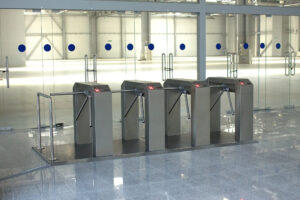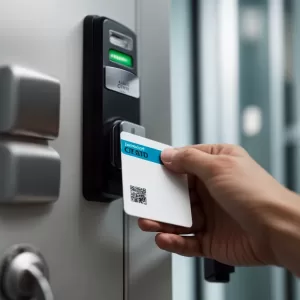Are you struggling to secure your business premises effectively? You’re not alone. Many business owners find themselves confused by the terminology surrounding security systems, particularly when it comes to entrance control and access control. While these terms are often used interchangeably, they represent fundamentally different approaches to securing your facility.
Understanding the distinction between entrance control and access control is crucial for making informed decisions about your security infrastructure. This comprehensive guide will break down the key differences, explore the capabilities of each system, and help you determine which solution best fits your business needs.
What is Entrance Control? 
Entrance control refers to basic security measures that monitor and manage who enters or exits a building or specific area. This traditional approach focuses primarily on physical barriers and simple authentication methods at entry points.
Core Components of Entrance Control
Entrance control systems typically include:
Physical Barriers: Locked doors, gates, turnstiles, and security checkpoints that create physical obstacles to entry.
Basic Authentication: Simple methods like keys, keycards, or PIN codes that verify identity at the point of entry.
Manual Monitoring: Security personnel who visually verify identities and monitor entry points.
Simple Logging: Basic records of who entered and when are often maintained manually or through simple electronic systems.
Limitations of Entrance Control
While entrance control provides a foundational level of security, it comes with significant limitations:
Limited Granularity: These systems typically operate on an all-or-nothing basis. Once someone gains entry to a building, they often have access to all areas within.
No Internal Monitoring: Entrance control focuses solely on the perimeter. Once inside, individuals can move freely without additional oversight.
Minimal Reporting: Most entrance control systems provide basic entry logs but lack detailed analytics or real-time monitoring capabilities.
Higher Security Risks: Without internal controls, a single compromised credential can grant access to sensitive areas throughout your facility.
What is Access Control? 
Access control represents a more sophisticated approach to security that manages and monitors access to specific resources, areas, or systems within your facility. This comprehensive system goes beyond simple entry management to provide granular control over who can access what, when, and under what circumstances.
Core Components of Access Control
Modern access control systems include:
Role-Based Permissions: Sophisticated systems that grant access based on job roles, clearance levels, or specific authorization requirements.
Multi-Factor Authentication: Advanced verification methods that may include biometrics, smart cards, mobile credentials, or a combination of authentication.
Real-Time Monitoring: Continuous surveillance of access attempts, successful entries, and suspicious activities across all controlled areas.
Detailed Audit Trails: Comprehensive logging that tracks not just who entered where, but also duration of access, attempted violations, and system changes.
Integration Capabilities: Seamless connection with other security systems, including surveillance cameras, alarm systems, and building management platforms.
Advanced Features of Access Control
What sets access control apart from entrance control is its advanced functionality:
Time-Based Restrictions: Automatically grant or deny access based on schedules, ensuring employees can only enter during authorized hours.
Zone-Based Security: Create multiple security zones within your facility, each with different access requirements and restrictions.
Visitor Management: Sophisticated systems for managing temporary access, including visitor registration, escort requirements, and automatic credential expiration.
Emergency Protocols: Integrated systems that can automatically unlock doors during emergencies or lockdown facilities during security threats.
Key Differences: Entrance Control vs Access Control
Understanding the fundamental differences between these systems will help you make the right choice for your business:
Scope of Control
Entrance Control: Focuses exclusively on building perimeter security. Once someone enters, they typically have unrestricted internal access.
Access Control: Provides comprehensive security throughout your facility, controlling access to specific rooms, floors, or areas based on individual permissions.
Security Sophistication
Entrance Control: Relies on basic authentication methods and simple physical barriers. Security breaches often go undetected until after incidents occur.
Access Control: Employs advanced authentication, real-time monitoring, and proactive threat detection. Security violations are immediately flagged and can trigger automated responses.
Scalability and Flexibility
Entrance Control: Limited scalability, requiring manual updates and physical key management. Adding new users or changing permissions is often time-consuming and error-prone.
Access Control: Highly scalable systems that can accommodate growing businesses. User management, permission changes, and system updates can be handled remotely and instantly.
Cost Considerations
Entrance Control: Lower initial investment but potentially higher long-term costs due to manual management, security risks, and limited functionality.
Access Control: Higher upfront investment but typically lower total cost of ownership due to reduced security risks, automated management, and operational efficiencies.
Compliance and Reporting
Entrance Control: Basic logging capabilities that may not meet regulatory requirements for detailed audit trails and compliance reporting.
Access Control: Comprehensive reporting and audit capabilities that support compliance with industry regulations and security standards.
Securing Your Business Future
The choice between entrance control and access control ultimately depends on your business’s unique requirements, growth plans, and risk tolerance. However, most modern businesses find that access control systems provide the security, flexibility, and scalability needed to protect their operations effectively.
Don’t leave your business security to chance. The right access control system can provide peace of mind, protect your assets, and support your growth objectives. Whether you’re upgrading from basic entrance control or implementing security measures for the first time, professional guidance can help you select and deploy the optimal solution for your needs.
Ready to take the next step in securing your business? Contact our security experts today for a comprehensive assessment of your facility and personalized recommendations for the most effective access control solution. Your business deserves the best protection available—and we’re here to help you achieve it.


